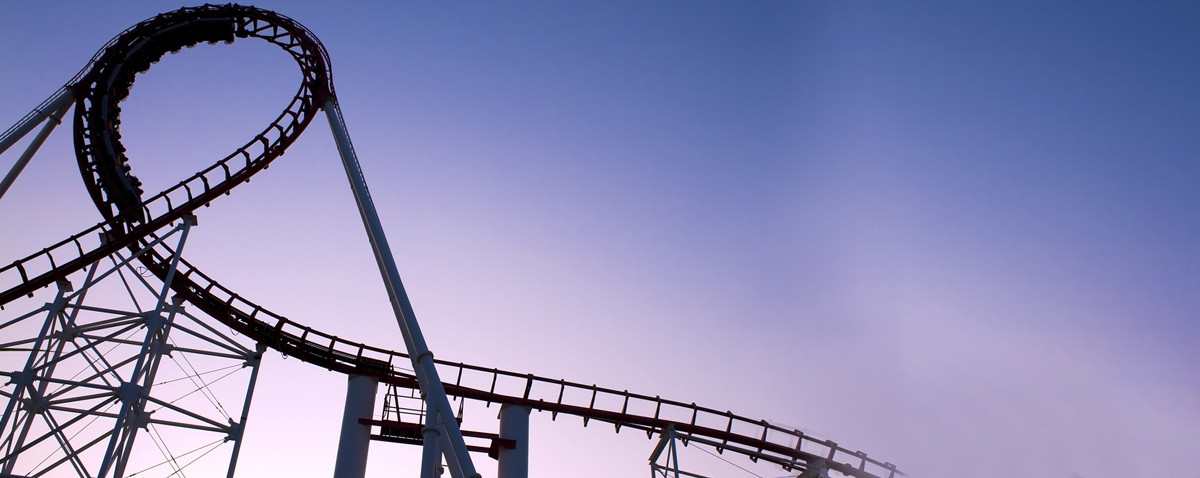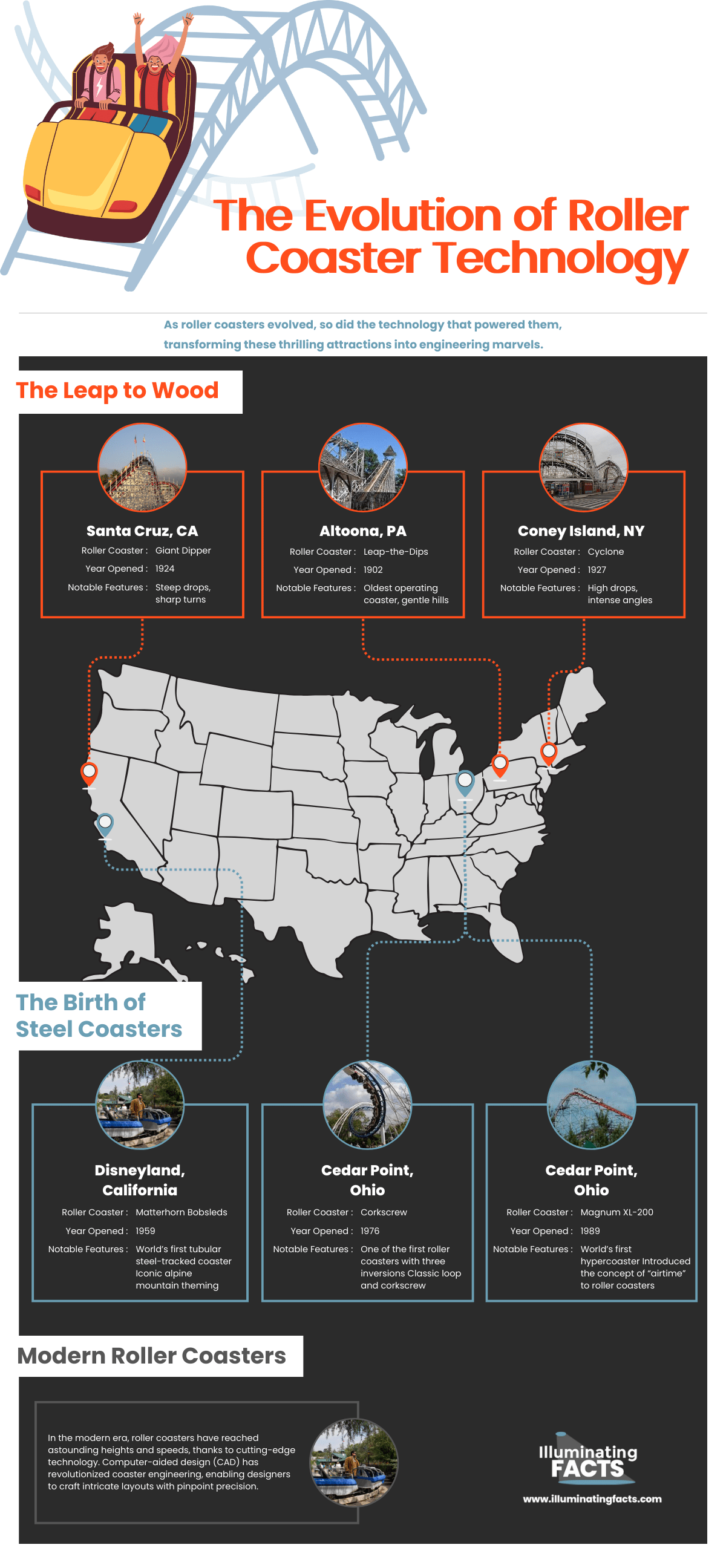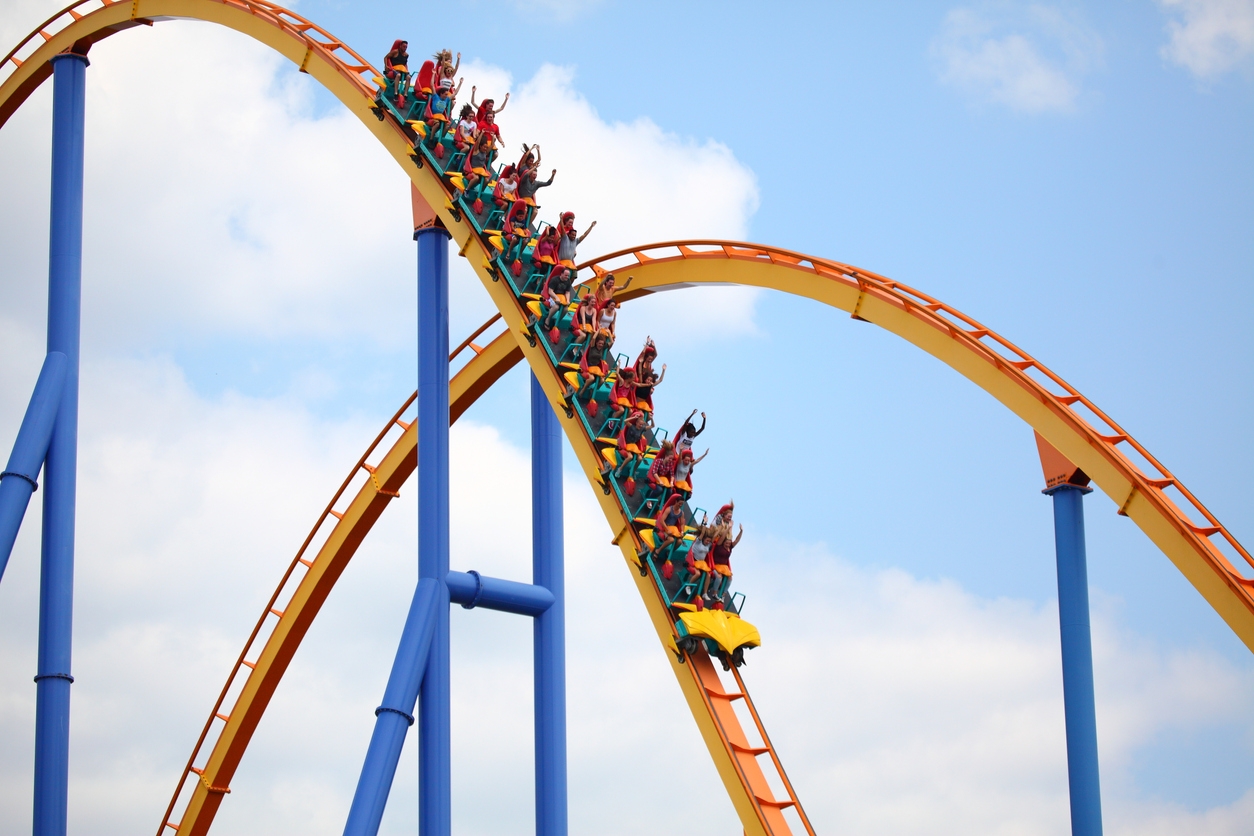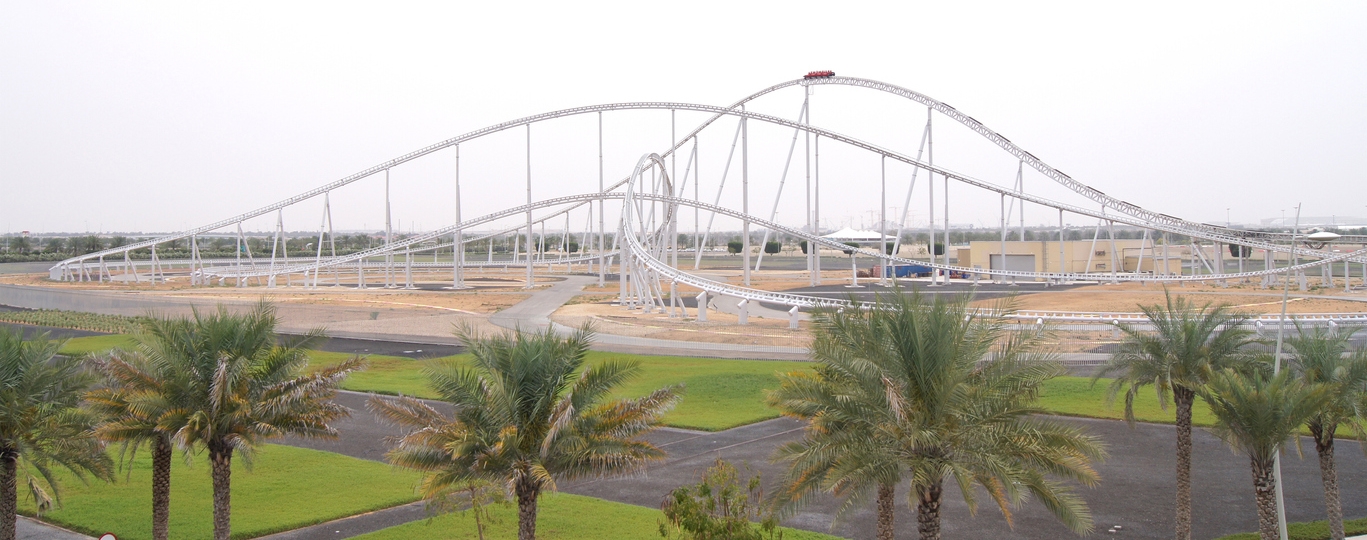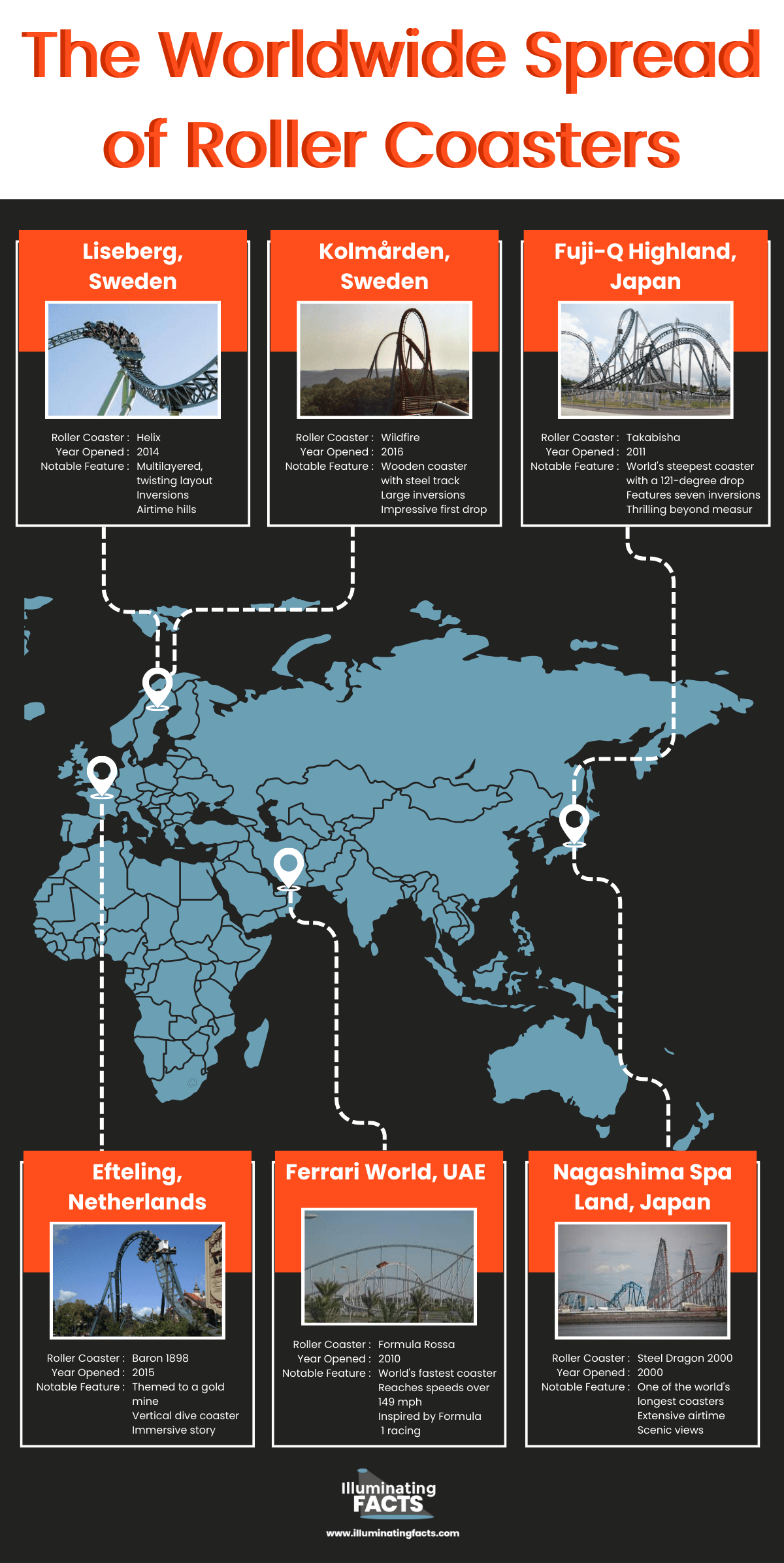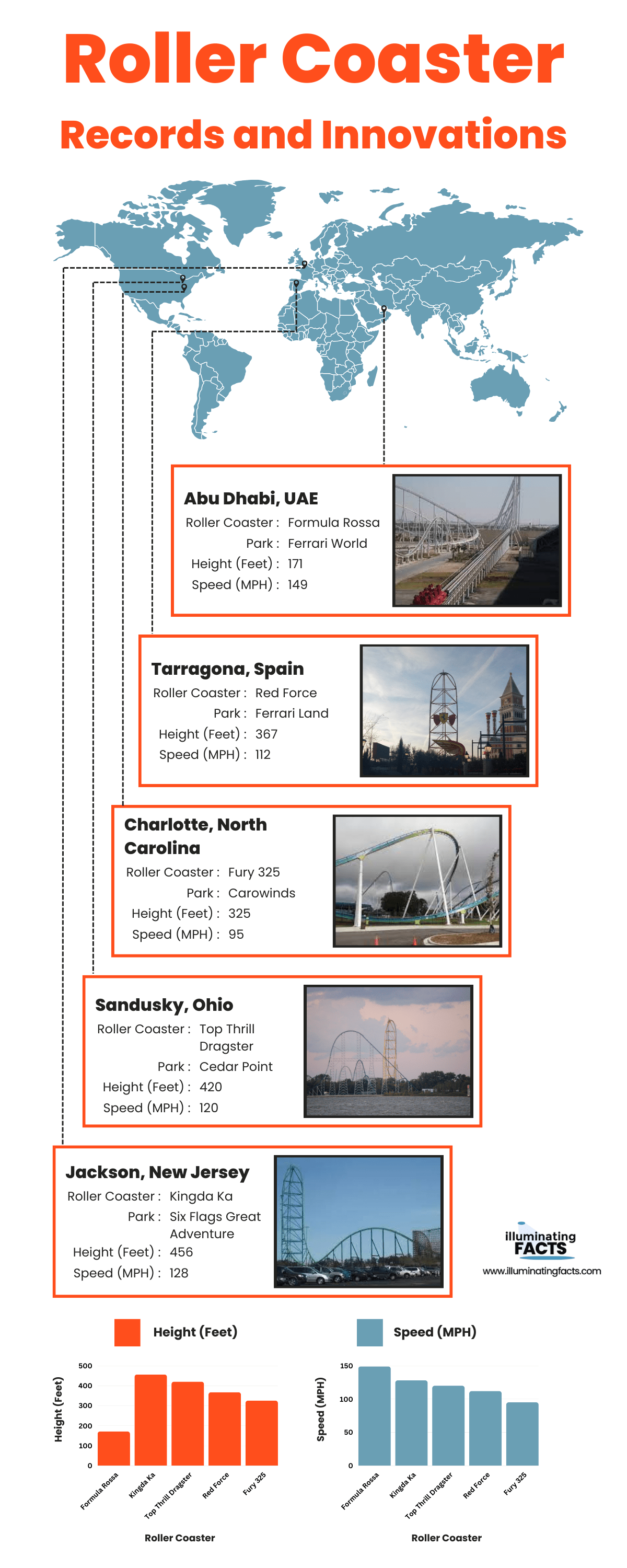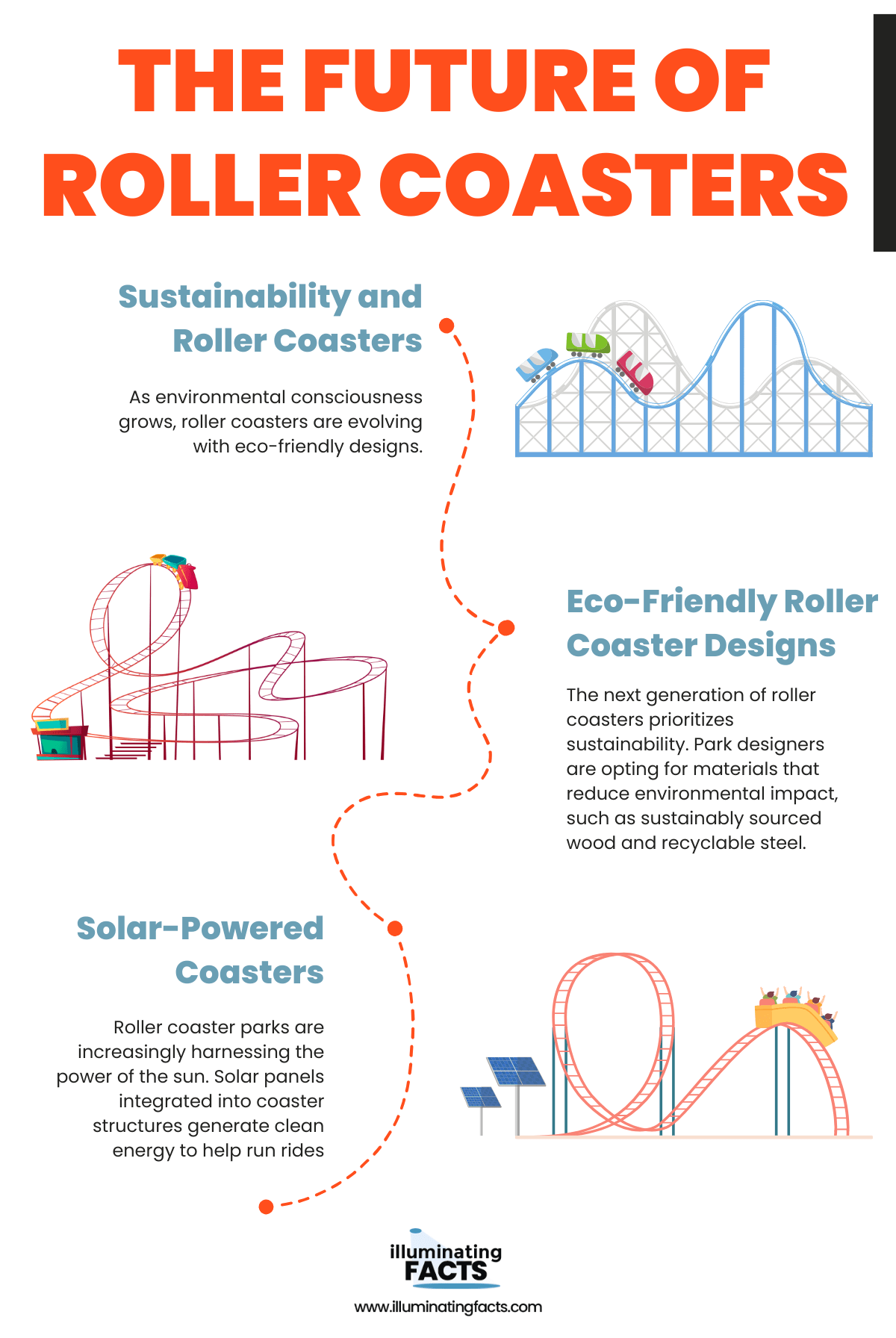Roller coasters are the embodiment of thrill-seekers’ dreams, offering an exhilarating experience that defies gravity and tests the limits of human endurance. They have become icons of amusement parks, drawing crowds from around the world to embark on a heart-pounding adventure. Picture this: a towering structure of steel and wood, its serpentine tracks winding high into the sky. The anticipation builds as you strap in, heart pounding, knowing that within moments, you’ll be hurtling through twists, loops, and drops at breakneck speeds. This adrenaline rush, this electrifying experience, is the essence of roller coasters.
While they are emblematic of amusement parks, roller coasters have transcended to become the very essence of these wonderlands of fun and excitement. The sight of their soaring layout is an invitation to adventure, a promise of a joyous escape from the ordinary. In this post, we delve into the history of how roller coasters rose to prominence as the centerpiece of amusement parks, drawing families, friends, and thrill-seekers to share in the excitement and create lasting memories.
Early Origins of Roller Coasters
Roller coasters have a fascinating history and evolution. This section uncovers their fascinating history, from their humble beginnings to their status as engineering marvels.
Precursors to Roller Coasters
Before the birth of modern roller coasters, there were precursors that set the stage for the thrill ride revolution.
Russian Ice Slides
In the heart of Russia’s frigid winters, the earliest semblances of roller coasters began to emerge in the form of ice slides. These slides, meticulously crafted on frozen surfaces, allowed enthusiasts to experience the exhilarating rush of sliding down icy slopes. [1] While rudimentary compared to modern roller coasters, they marked an initial fascination with gravity-driven rides.
Early Russian Mountains
Parallel to the development of ice slides, early Russians experimented with wooden structures referred to as “Russian Mountains.” [2] These precursors featured wooden hills and ramps, intended to simulate the sensation of coasting down mountainsides. The evolution from ice slides to these wooden contraptions signified an evolving appetite for gravity-defying adventures.
The “Russian Mountain” in France
In France, the term “Russian Mountain” took on a whole new meaning, catalyzing the evolution of roller coasters as we know them today. French engineers and showmen took the concept of the “Russian Mountain” to new heights, both literally and figuratively. They refined the design, incorporating innovations that marked the birth of the roller coaster as we now recognize it. It was a pioneering step that would soon ripple across the globe.
The Mauch Chunk Switchback Railway
In the United States, the spark of roller coaster enthusiasm ignited with the introduction of the Mauch Chunk Switchback Railway. Situated in Pennsylvania, it earned the distinction of being America’s inaugural roller coaster. It laid the groundwork for the flourishing world of roller coasters in America and beyond.
This gravity-powered railway, initially constructed for the transport of coal, rapidly gained popularity as an entertainment attraction. [3] It was here, on these wooden tracks, that Americans first tasted the thrills and chills of a roller coaster ride. The success of the Mauch Chunk Switchback was at the forefront of a gravity railroad phenomenon that swept across the United States during the 19th century.
The Evolution of Roller Coaster Technology
As roller coasters evolved, so did the technology that powered them, transforming these thrilling attractions into engineering marvels.
| Era | Key Advancements | Example |
| Early 20th Century | Gravity-powered wooden coasters | The Giant Dipper |
| Mid-20th Century | Introduction of tubular steel tracks | Matterhorn at Disneyland |
| Modern Era | Computer-aided design (CAD)
Record-breaking heights and speeds |
Formula Rossa and Kingda Ka |
The Leap to Wood
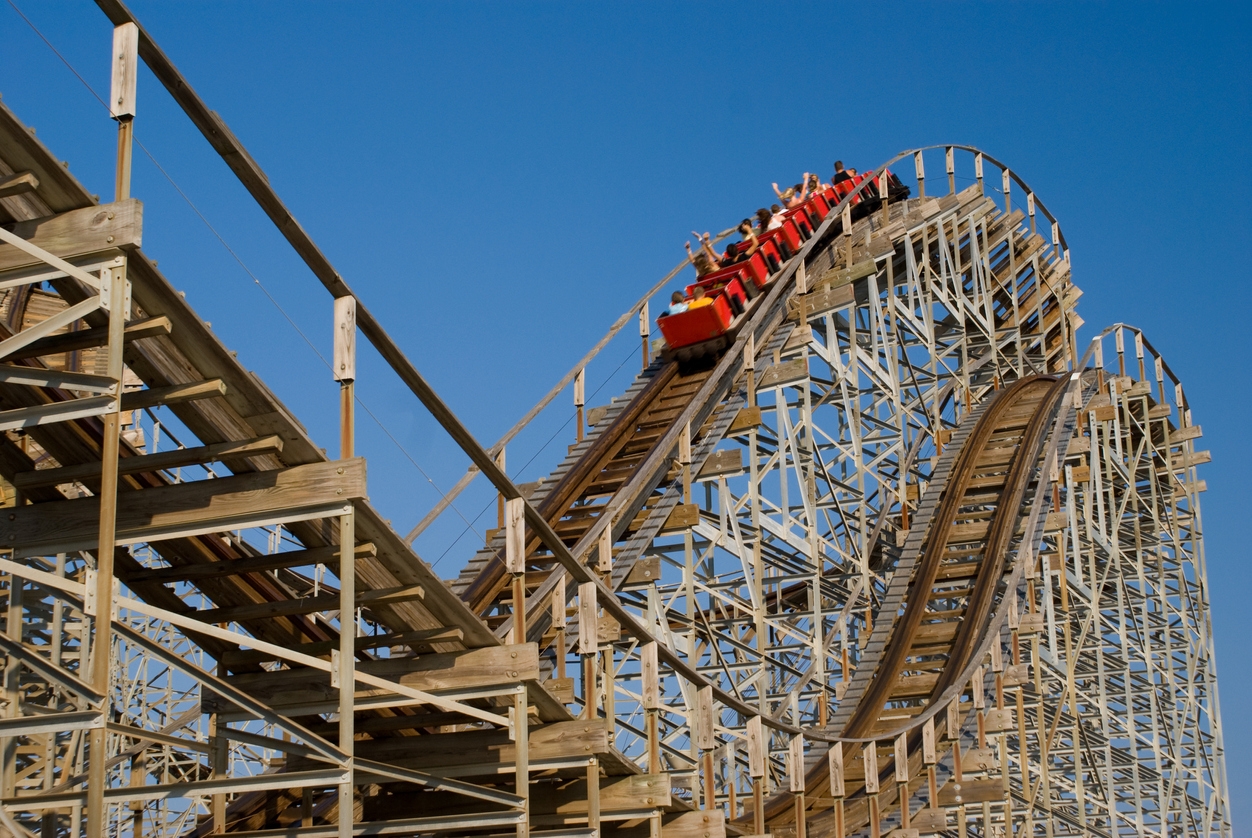
The transition to wooden roller coasters marked a significant turning point in the history of this adrenaline-pumping ride.
The early 20th century witnessed the emergence of gravity-powered wooden coasters. These coasters, constructed primarily from timber, featured thrilling drops, sharp turns, and unadulterated excitement. The Giant Dipper in Santa Cruz [4] and the Leap-the-Dips in Pennsylvania [5] exemplify this era of wooden coaster ingenuity.
A game-changer in the wooden coaster realm, the Cyclone at Coney Island introduced a radical departure from conventional coaster design. [6] Its steeper drops and sharper angles delivered an unmatched level of exhilaration. This iconic ride became a model for future wooden coasters, setting the bar high for thrill-seekers.
| Roller Coaster | Location | Year Opened | Notable Features |
| Giant Dipper | Santa Cruz, CA | 1924 | Steep drops, sharp turns |
| Leap-the-Dips | Altoona, PA | 1902 | Oldest operating coaster, gentle hills |
| Cyclone | Coney Island, NY | 1927 | High drops, intense angles |
The Birth of Steel Coasters
Steel coasters revolutionized the industry, offering unprecedented smoothness and versatility. In 1959, Disneyland unveiled the Matterhorn Bobsleds, a groundbreaking roller coaster featuring tubular steel tracks. [7] This innovation brought a newfound level of precision and smoothness to coaster design. Riders could now experience the twists and turns of the Matterhorn with unparalleled comfort.
The introduction of tubular steel tracks opened the door to mind-bending inversions. Coasters like the Corkscrew at Knott’s Berry Farm showcased these daring maneuvers, turning riders upside down and redefining the limits of coaster thrills. [8] Steel coasters quickly gained popularity for their versatility and spine-tingling elements.
Roller Coaster | Location | Year Opened | Notable Features |
Matterhorn Bobsleds | Disneyland, California | 1959 | World’s first tubular steel-tracked coaster Iconic alpine mountain theming |
Corkscrew | Cedar Point, Ohio | 1976 | One of the first roller coasters with three inversions Classic loop and corkscrew |
Magnum XL-200 | Cedar Point, Ohio | 1989 | World’s first hypercoaster Introduced the concept of “airtime” to roller coasters |
Modern Roller Coasters
In the modern era, roller coasters have reached astounding heights and speeds, thanks to cutting-edge technology. Computer-aided design (CAD) has revolutionized coaster engineering, enabling designers to craft intricate layouts with pinpoint precision. Coasters like the 0at Six Flags Great Adventure exemplify this new era, boasting dizzying heights and lightning-fast launches. [9]
Today’s roller coasters push the boundaries of physics and engineering. Coasters like the Formula Rossa in Abu Dhabi [10] propel riders at speeds exceeding 149 mph, while the Top Thrill Dragster at Cedar Point catapults them to heights of 420 feet. [11] These record-breaking feats continue to captivate thrill-seekers worldwide, proving that the roller coaster’s evolution knows no limits.
Roller Coasters Go Global
As roller coasters gained popularity, they transcended borders, finding homes on every continent. The global spread brought unique design influences and cultural elements to this heart-pounding ride.
The Worldwide Spread of Roller Coasters
In Europe, a renaissance of coaster design emerged. European coasters are known for their intricate layouts and attention to detail. Iconic examples include the Eurofighter coasters with vertical drops and the wooden coasters found at the biggest theme parks of the world.
Roller Coaster | Location | Year Opened | Notable Feature |
Helix | Liseberg, Sweden | 2014 | Multilayered, twisting layout Inversions Airtime hills |
Wildfire | Kolmården, Sweden | 2016 | Wooden coaster with steel track Large inversions Impressive first drop |
Baron 1898 | Efteling, Netherlands | 2015 | Themed to a gold mine Vertical dive coaster Immersive story |
The 21st century witnessed an explosion of roller coaster development in Asia and the Middle East. Countries like Japan and the United Arab Emirates embraced coaster innovation. Notable attractions include the Steel Dragon 2000 in Japan, one of the world’s longest coasters, and the Formula Rossa in Abu Dhabi, known for its record-breaking speed.
Roller Coaster | Location | Year Opened | Notable Feature |
Steel Dragon 2000 | Nagashima Spa Land, Japan | 2000 | One of the world's longest coasters Extensive airtime Scenic views |
Formula Rossa | Ferrari World, UAE | 2010 | World's fastest coaster Reaches speeds over 149 mph Inspired by Formula 1 racing |
Takabisha | Fuji-Q Highland, Japan | 2011 | World's steepest coaster with a 121-degree drop Features seven inversions Thrilling beyond measure |
Cultural Influences on Roller Coaster Design
Cultural influences have left an indelible mark on roller coaster design, giving rise to themed and immersive coaster experiences. Roller coasters began incorporating elements of mythology and storytelling. Coasters like Universal’s “Hagrid’s Magical Creatures Motorbike Adventure” draw inspiration from the Harry Potter series, providing riders with immersive, narrative-driven experiences that transport them to the wizarding world. [12]
In various regions, roller coasters have started to incorporate local cultural elements. For example, Happy Valley in Beijing is inspired by ancient Chinese mythology. Similarly, there is a desert-themed coaster in the Middle East. These attractions pay homage to their surroundings, adding a layer of authenticity to the ride experience.
Roller Coasters in Pop Culture
Roller coasters have embedded themselves in popular culture, making appearances in various forms of entertainment and even influencing music.
Roller Coasters in Films and TV Shows
From the breathtaking chase scene featuring the Cyclone at Coney Island in “The Warriors” to the gravity-defying stunts on a coaster in “Rollercoaster” (1977), these attractions have become integral to Storytelling. The “Final Destination” film series is known for its inventive and horrifying death scenes. In “Final Destination 3,” a spine-tingling sequence takes place on a roller coaster, demonstrating the visceral terror that these rides can evoke. Such scenes have solidified roller coasters’ status as harbingers of adrenaline and suspense.
Film/TV Show | Year | Roller Coaster | Significance in the Plot |
The Warriors | 1979 | Cyclone at Coney Island | High-intensity chase scene set on a roller coaster. |
Final Destination 3 | 2006 | Devil's Flight Roller Coaster | Roller coaster scene is a pivotal moment, showcasing the ride's danger. |
Rollercoaster | 1977 | Various coasters | Thriller film centered around a terrorist targeting amusement park roller coaster. |
Roller Coasters in Music
Besides TV, roller coasters have also been exploring the business of music. Countless songs and lyrics draw parallels between life’s unpredictability and the exhilaration of a roller coaster ride. Classic tunes like “Rollercoaster” by Bleachers and “Roller Coaster” by Luke Bryan capture the emotional highs and lows that these attractions symbolise.
Roller Coaster Records and Innovations
The world of roller coasters continually pushes boundaries, setting records and introducing groundbreaking innovations.
Roller Coaster | Park | Location | Height (Feet) | Speed (MPH) |
Formula Rossa | Ferrari World | Abu Dhabi, UAE | 171 | 149 |
Kingda Ka | Six Flags Great Adventure | Jackson, New Jersey | 456 | 128 |
Top Thrill Dragster | Cedar Point | Sandusky, Ohio | 420 | 120 |
Red Force | Ferrari Land | Tarragona, Spain | 367 | 112 |
Fury 325 | Carowinds | Charlotte, North Carolina | 325 | 95 |
These roller coasters stand as engineering marvels, offering riders breathtaking heights and exhilarating speeds, making them must-visit attractions for thrill-seekers.
The Future of Roller Coasters
The future of roller coasters is marked by sustainability initiatives and an infusion of cutting-edge technology.
Sustainability and Roller Coasters
As environmental consciousness grows, roller coasters are evolving with eco-friendly designs.
Eco-Friendly Roller Coaster Designs
The next generation of roller coasters prioritizes sustainability. Park designers are opting for materials that reduce environmental impact, such as sustainably sourced wood and recyclable steel. Innovations like regenerative braking systems aim to harness and store energy generated during the ride.
Solar-Powered Coasters
Roller coaster parks are increasingly harnessing the power of the sun. Solar panels integrated into coaster structures generate clean energy to help run rides, making amusement parks more self-sufficient and reducing their carbon footprint.
Integrating Technology and Storytelling
The future promises immersive storytelling experiences through the integration of technology into roller coasters. Augmented reality (AR) is transforming coaster narratives. AR headsets provide riders with interactive digital overlays, creating entirely new worlds to explore during the ride. This technology blurs the lines between reality and fantasy, enhancing the thrill.
Coaster elements are also becoming interactive. Riders can steer, aim, or trigger in-game events through onboard controllers or smartphone apps. This level of engagement allows for a personalized experience, where each ride can be unique.
Conclusion
Roller coasters, with their rich history and ever-evolving innovations, remain an enduring symbol of thrill and excitement. From the heights of Kingda Ka to the speed of Formula Rossa, these structures have continuously pushed the boundaries of what’s possible in the world of amusement parks. They’ve become icons, not just for their breathtaking rides, but also for their contributions to engineering marvels. The infusion of technology, from augmented reality to interactive elements, promises to make each ride a unique adventure.
References
- Way before roller coasters, Russians zipped down enormous ice slides. (2019, August 22). Atlas Obscura. https://www.atlasobscura.com/articles/russian-roller-coasters
- Visit, M. P. (n.d.). My Park visit. My Park Visit – Theme Park Planning Tools and Recommendations. https://www.myparkvisit.com/Blog/1007/The%20First%20Roller%20Coaster
- Conservancy, R. (n.d.). History happened here: How the switchback railroad inspired the invention of the roller coaster. Rails-to-Trails Conservancy. https://www.railstotrails.org/trailblog/2014/september/12/history-happened-here-how-the-switchback-railroad-inspired-the-invention-of-the-roller-coaster/
- Ferrell, J. (2021, November 15). This wooden roller coaster in Santa Cruz is nearly 100 years old. Secret San Francisco. https://secretsanfrancisco.com/santa-cruz-boardwalk-giant-dipper/
- Destination PA: LEAP the dips, world’s oldest roller coaster. (2022, June 29). WJET/WFXP/YourErie.com. https://www.google.com/amp/s/www.yourerie.com/community/destination-pa/destination-pa-leap-the-dips-worlds-oldest-roller-coaster/amp/
- Aceonline.org. (n.d.). aceonline.org. https://www.aceonline.org/page/CICyclone
- What is the Matterhorn bobsleds drop height? (2022, August 14). Enchanting Mouse – Your Destination To A Magical Adventure. https://enchantingmouse.com/what-is-the-matterhorn-bobsleds-drop-height/
- Roller coaster of the day: Corkscrew – Silverwood theme Park. (2013, December 19). Seung Park. https://mountainmadman.wordpress.com/2011/03/28/roller-coaster-of-the-day-corkscrew-silverwood-theme-park/
- Kingda Ka. (n.d.). Wikiwand. Retrieved September 8, 2023, from https://www.wikiwand.com/en/Kingda_Ka
- World’s fastest rollercoaster: Could you stomach it? (2010, October 26). BBC News. https://www.google.com/amp/s/www.bbc.com/news/world-middle-east-11620485.amp
- TODAY, U. (2023, August 1). Cedar Point unveils reimagined, 420-foot-tall top thrill 2 roller coaster after two-year closure. Detroit Free Press. https://www.usatoday.com/story/travel/experience/theme-parks/2023/08/01/cedar-point-top-thrill-2/70503850007/
- Tuttle, B. (2019, March 12). New details revealed for Hagrid’s magical creatures motorbike adventure at Universal Orlando. Attractions Magazine. https://attractionsmagazine.com/hagrids-magical-creatures-details/

